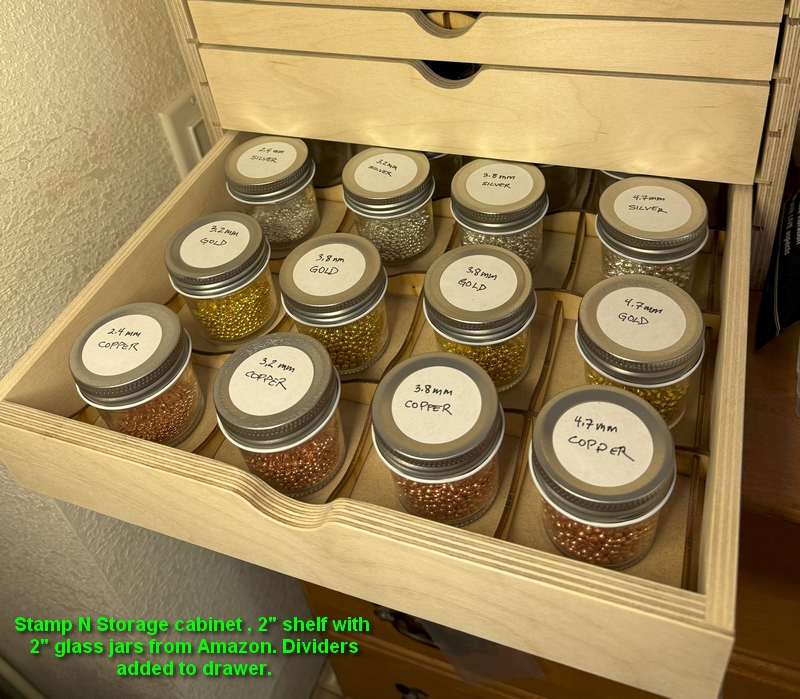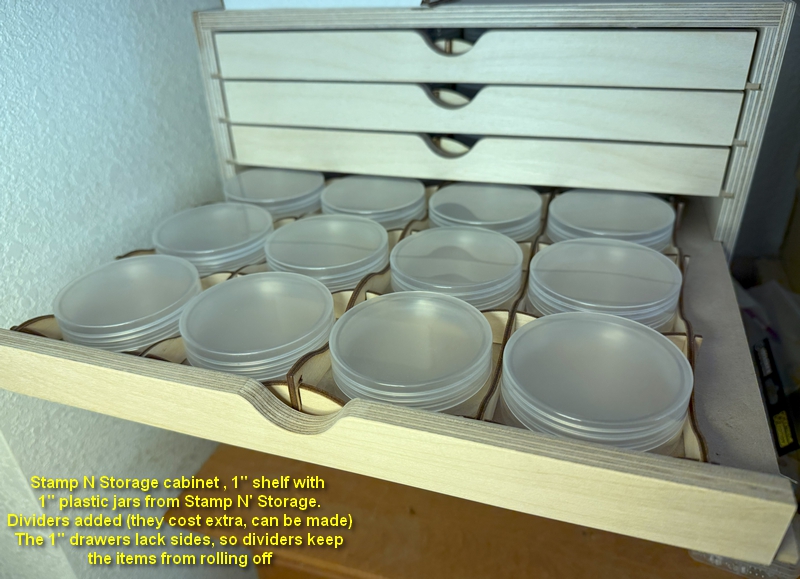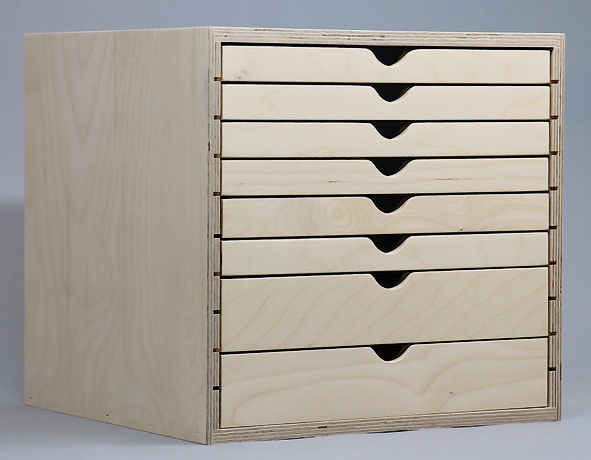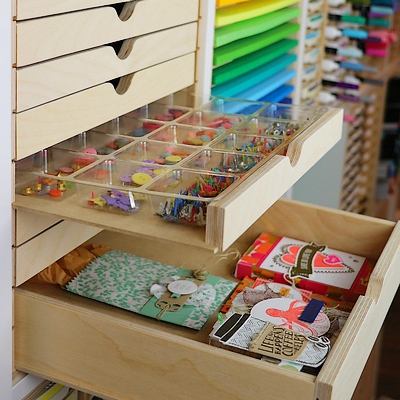I wasn’t surprised I had nearly 32 sizes of brass beads, in 8 colors, it was all the nooks and crannies I’d wadded the little baggies into that was the revelation. Once you factor colors and sizes; Silver, Gold, Copper, Black Nickel, in at least four sizes; 4mm, 3.8mm, 3.2mm, and 2.4mm … add in those Olive and Coffee Brown beads you thought irresistible, and the White 2.4mm that you need for Shad, the four sizes of Coneheads for all the Bass minnows you throw … the combination of little plastic bags tucked into drawers, becomes a mess.
Then there’s the fish hook issue. Old hooks in paper boxes, newer hooks in plastic boxes, recent purchases in those silly plastic sleeves, and even though it’s the same hook in three different sized containers, it’s not possible to save them all in the same drawer, and you have hooks spread out among all of your storage choices.
You might say, I’ve had enough …
It used to be a few thread spools we couldn’t find a place for … or an odd lot of tinsels, but now our craft is full of little bits of plastic, little metal beads, things that rattle, things that sparkle, and all of it changes shape everytime the vendor has a fit of pique, regardless of what our storage can handle.
When I started tying it was the Porcupine purchase that made me realize I needed to upgrade my storage. Back then everything was in a cardboard wine box. The smaller the item the deeper it sank into the mix, so routinely I would plunge into the box looking for yellow hackle and have to dig. One day I plunged into the box and came out attached to my chunk of Porcupine hide, and the plasticine baggy it was in offered zero protection to my now-bleeding fingers.
I upgraded to a desk dedicated to fly tying. This meant the Porcupine could be safely stored away from both my loyal hound, and my grabbling digits.
I think we’re there again. Desks no longer offer the kind of small item storage we now need, as their drawers simply aren’t segregated enough to offer their contents efficiently when searched. Little boxes cannot be stacked next to envelopes of fish hooks, as we cannot see their labels and must “deal” them onto the table like cards, to find the Dry Fly #12’s.
What’s needed is the ability for us to decant the vendor’s containers into a standard container of our own choosing, that will allow us to label and store with others of the same size and type.
… and that’s the easy part of the quest, defining the problem.
In all my wandering through craft stores, only the beading community seems to share our problems with storage and container. They’re afflicted by countless small beads and the need to keep them all seperate and within arm’s reach. Figure they got a dozen different sizes and unlimited colors, and their work surface is as cluttered as ours …
I’ve been eyeballing some of their storage solutions. Lots of wonderful little jars that would accomodate hooks swimmingly, we just need the jars to fit within the confines of our existing furniture solution … or add something they will fit into.
A 1″ inch jar is perfect for all the small hooks up to and including 6’s and 8’s, but the big hooks for poppers, saltwater, and the long shank streamers will require a larger jar.
One thousand 3.8mm brass beads will fill a one inch jar to the brim. 5mm beads will fit about 500-600 in a one inch container, so it looks like both the one and two inch jars are needed for a comprehensive solution. The two inch jar can handle the big hooks (by the one hundred pack) as well as the larger beads, coneheads, rattles, and fish heads needing storage.
The above links are for glass and plastic jars. I opted for glass over plastic, given many forms of plastic age poorly and become cloudy, brittle and opaque. Glass allows me to attach labels either to the glass or the metal lids – allowing me to peel or scrape them off year’s later with no damage to the container. Glass is heavier, and if I leave the container on the surface of my tying bench, will resist being brushed off onto the floor much better than plastic. Think several hundred size 16’s sprinkled onto your sock feet and carpet…
The small jars are part of the answer, but what to put the jars into is the balance of the question. Most desks contain four or six drawers in several sizes, and not all are suitable for the one inch size without stacking them. Stacked jars work, but it makes searching for the hook you want a little harder than specialized storage that shows ALL the labels on the jars at once.
I’ve opted to start with the Stamps and Storage Wooden Drawer Cabinet, to test its storage and retrieval of all my items. It can be purchased with different height drawers, so you can choose the jar sizes best suited for your tying. My first purchase was configured with six one inch drawers and two, two inch drawers. I purchased the dividers to compartment the one inch drawers into sixteen smaller squares, ditto for the two inch drawers. Each 1″ drawer can fit 16 jars, so I have a total of 96 1″ inch jars, and 32 2″ jars, or 128 seperate storage vessels.
Awesome. But Expensive.
The one inch drawers have no sides to them, only fronts and backs, so the strips of divider wood that make them into 16 individual compartments are necessary. The 2″ drawers have all four sides, making the subdividers uneccessary.
I’m thinking the 1″ drawers equipped with 1″ bottles are perfect for hooks, the 2″ drawers with 2″ bottles are for everything else. It’s likely that each unit may have a different configuration, should more than one cabinet be purchased.
The size of the unit will allow it to be used on your table, or located somewhere’s else. This is useful to pre-position all the frequently used sizes of hooks and beads, close to the work area for use. Offloading these items out of your desk storage will then allow you to reposition and optimize certain drawers for use with additional glass jars, making your desk hold additional small items.

With 134 compartments in one cabinet (as configured above) you have all of your small things available in storage that will never change shape, and will always have accurate labels, as you can peel the old and replace with the new.
I will be stockpiling a few flies going forward, as Winter is long and I keep fiddling with new patterns and ideas. If this cabinet works well, I will add a couple more configured with only the 2″ drawers to contain additional jars. If you figure 10 nymphs and 6 dries, that’s only a single drawer out of the six, so I don’t need to go overboard on the small size.

The 2″ drawers are better suited for the larger flies, so if I get industrious I might stash some leechs or big stoneflys. I probably not use these for feather storage as the handle area allows bugs access, and a sealed container is always the first line of defense.
Instinct suggests that while a beginning tyer could shift all of his hook storage into one unit, I should not. Firstly, because I have hoarded quite a bit more than your average beginner, and secondly, it’s the most commonly used hooks that i need storage for, not the odd, ancient, or esoteric crap I have squirrelled away. While you might still own Mustad 94840’s in paper containers, plastic containers, and plastic sleeves, you probably only own one type of container for Salmon double hooks, as they’re illegal in most California creeks.
I will be consolidating my trout nymph and trout dry fly hooks to these containers due to the mix of storage types the manufacturers chose over the last decade. The ancient Allcock hooks, and the Carrie Steven’s Streamer hooks I got from Partridge, are hoarded items that I don’t need close to hand.
Whether this makes it to my desk surface is another question. The one inch drawers work well for threads and tinsels, fish hooks, and small amounts of beads, but you’ll need to make sides for those drawers or buy the dividers from Stamps N’ Storage to ensure things don’t roll off the sides when opening and closing them.
The drawers have dividers in numerous configurations, so you need to determine what container size you’ll be using in order to purchase the dividers. I bought the larger size grid, with 16 compartments, but they make many more options. (Note that this 16 compartment option is only available after clicking the Configuration option on the purchase screen, it is not shown)
My desk has several shallow drawers that I had been using for hooks and beads, and now are available for other items, like tools, or packaged dubbing assortments. Offloading the small item storage to the cabinet has freed several drawers to pack with other things that are better behaved in shallow drawers.
The carousels look quite useful also, but I’ll wait on those until I’ve integrated the cabinet. Even without containers in them, I can see filling one with threads and tinsels, wires spools, lead, and bead chain.


